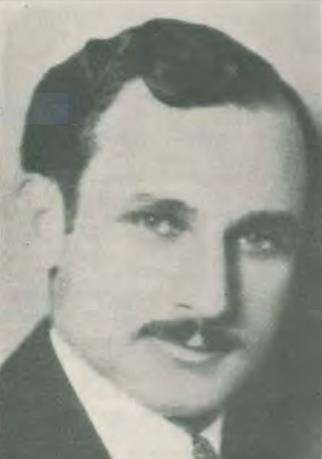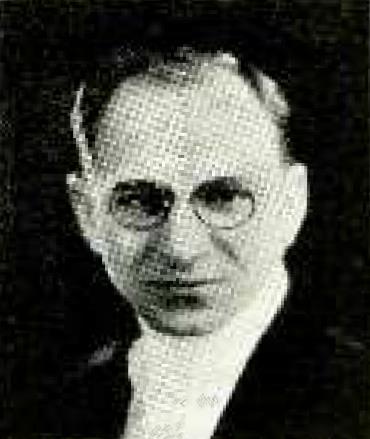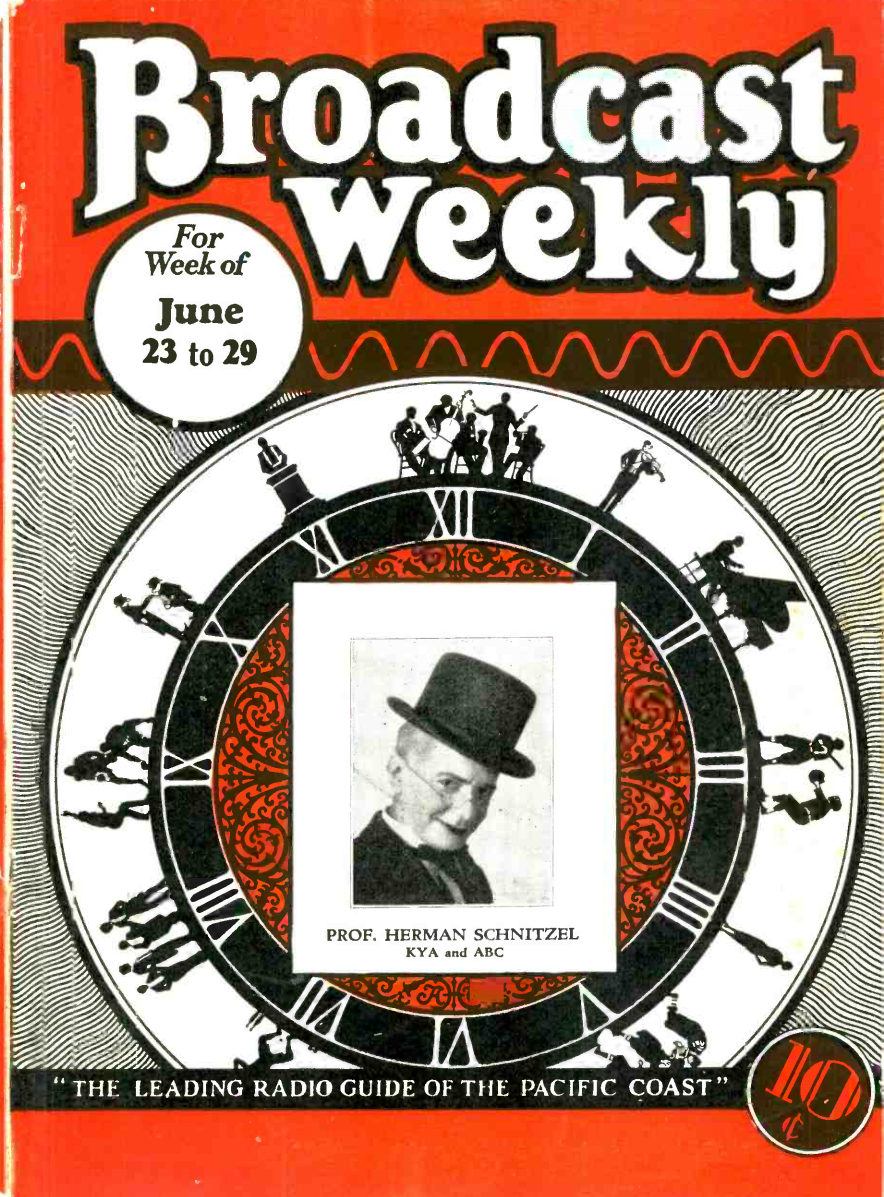America's history through the lens of 20th century broadcast media
Copyright 2020 Greenstone Media Consulting, LLC
ABC Network - 1929 - Key Programming Personnel

|
John R Britz - Vocal Director, ABC's San Francisco Division. Hungarian born musician, he was a cellist in the Ziegfeld Follies Orch. in the U.S., spent time in Portland as the director of a theatre orchestra and member of the Portland Symphony, before moving to San Francisco to join the ABC staff on January 1, 1929. He specialized in light opera/operetta works. |
| Henry Damski - Conductor, Puget Sound Savings and Loan Orchestra. Damski frequently led various ABC musical ensembles. After ABC's demise he was music director for KJR and numerous other radio stations in the 1930s. | |
| Liborius Hauptmann - Musical Director, San Francisco of ABC's San Francisco Division. Born in Vienna, he exhibited musical talent at an early age. Following graduation he was sent to Geneva as a music professor. Arriving in the U.S. we worked as an engineer before returning to music. Worked at KGW, Portland before leaving for KYA in 1925. | |
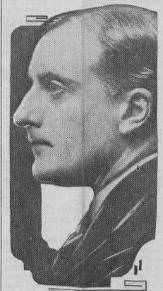
|
Jacques Joujerville - Director, American Opera Company. Joujerville (also spelled Jou-Jerville) was a singer and vocal coach who also performed with the Seattle Opera Society. He later pursued a movie career and was cast in several films including The Eagle and the Hawk starring Frederick March and Cary Grant. |

|
Herman Kenin - San Francisco-based orchestra leader of various ABC offerings including the Golden Gate Gypsies. Raised in Portland, Kenin played in George Olson's orchestra before Olson left for Broadway. Remaining in Portland, Kenin formed his own band to fulfill Olson's commitments, performed for several years in Portland before leaving for San Francisco where his band came to the attention of Victor Records for whom they recorded. Following ABC's demise, he was engaged by the Ambassador Hotel in Los Angeles, continuing to make more sides for Victor Records, before leaving the performing world to pursue a law degree back in Portland. In 1958 he succeeded James Petrillo as president of the American Federation of Musicians. |
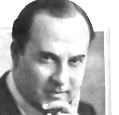
|
Francesco Longo - American Philharmonic Orchestra, conductor. Conducted the first transcontinental radio program originating in the Pacific Northwest. A talented flutist and pianist (he was accompanist to opera stars Louisa Tetrazzini and Riccardo Stracciari), conducted the 30-piece Rivoli Theatre Orchestra in Portland, Oregon till January 1925 before taking a similar position in Seattle in 1927 where he was also the conductor of the Columbia All-Artist Orchestra. He died in 1933. |
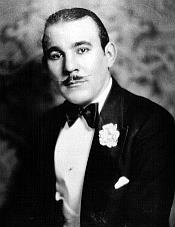
|
Vic Meyers - Vic Meyers Recording Orchestra. Raised in Oregon, In his teens played drums professionally, put together a 10-piece band and was given a 2-year contract in 1919 to lead the house band at the Rose Room in Seattle’s Hotel Butler for several years. Began recording for Brunswick Records in 1923 billed as "Vic Meyers Hotel Butler Orchestra". In 1927 his band first got a residency at Seattle's Trianon Ballroom and they began recording for Columbia Records. Frequent performing on ABC including ABC late night offerings which included skits with music. A buoyant personality with a flair for humor, his role in those programs was significant. After dabbling in a career change to politics, he was eventually elected Washington State's 11th Lieutenant Governor and eventually Washington's Secretary of State. |
| Albert M. Ottenheimer - playwright who wrote The Chronicles of Katz for ABC and was a member of the cast of ABC's Harper's Corner. Ottenheimer was an actor, author and a founder of the Seattle Repertory Playhouse, and founding member of the Seattle local of the American Federation of Radio Artists. Shortly after graduating from the Univ. of Washington he wrote The Chronicles of Katz series for ABC. Blacklisted during he kept a diary Ottenheimer kept during his 30-day jail sentence. Among other credits, he was in the cast of the US and European touring companies for West Side Story and in the Woody Allen films Annie Hall and The Front. | |
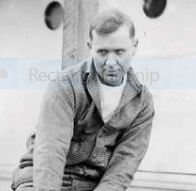
|
James Stevens - was the most well-established author engaged by ABC as a scriptwriter. At ABC Stevens wrote The Histories of Paul Bunyon which were based upon his 1925 book about Bunyan. Stevens mixed tradition and invention in his book about Bunyan and its huge success both transformed Bunyan into a major topic as well as propelled him into national stature as an author. A protégé of H. L. Menken, editor of the influential American Mercury magazine. He grew in professional stature to the point that he was dubbed the dean of Pacific Northwest authors. Over his career he wrote 9 books and over 250 published stores and magazine articles. Coming so soon after his 1925 book, his ABC series both drew and expanded upon his research and recitation of the Bunyan legends. |
Thomas Freebairn Smith - Announcer. The Scottish-born Smith, known as Tommy during ABC's lifetime, remained with KJR long after ABC's demise.
|
|
| Clarence Coleman - was a dialect humorist who appeared on various ABC programs as Dr. Herman Schnitzel. A San Francisco real estate broker in real life, his Dr. Herman Schnitzel character first emerged in 1926 but soon found its way onto the "KFRC Jamboree" program the next year. Racial humor flourishing on stereotypic portrayals was common and Schnitzel quickly became popular. Coleman continued his real estate career while actively presenting Schnitzel both on radio and in vaudeville performances. Like Cecil and Sally, he was appearing on KYA before ABC's launch and then became a frequent participant in various ABC network programs. He often appeared with the Golden Gate Gypsies who were, at the time, headed by Herman Kenin, although he also appeared on "Harmonyland" with the Rhythm Aces. Appearing in a high silk hat and Prince Albert coat, he reportedly only knew three German words yet occasionally had real visiting Germans fooled when they tried to converse with him in their language. Known as "Der Feetsball Foolisher" and Doctor of Nonsense at the University of Cincinnopolis, following ABC's collapse he appeared on various San Francisco local stations and NBC Orange before landing a regular berth on KNX/CBS. |
